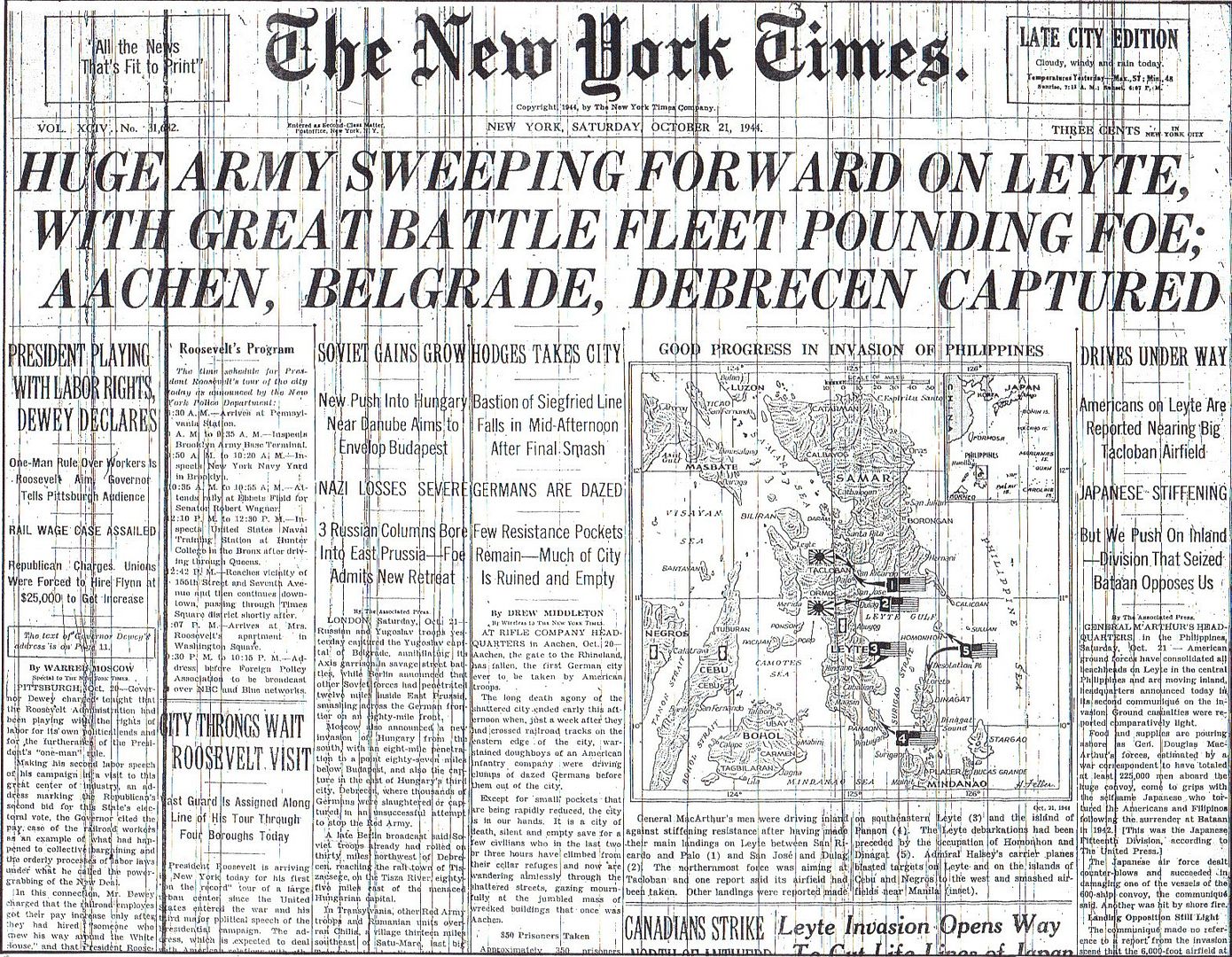
Posted on 10/21/2014 4:41:10 AM PDT by Homer_J_Simpson



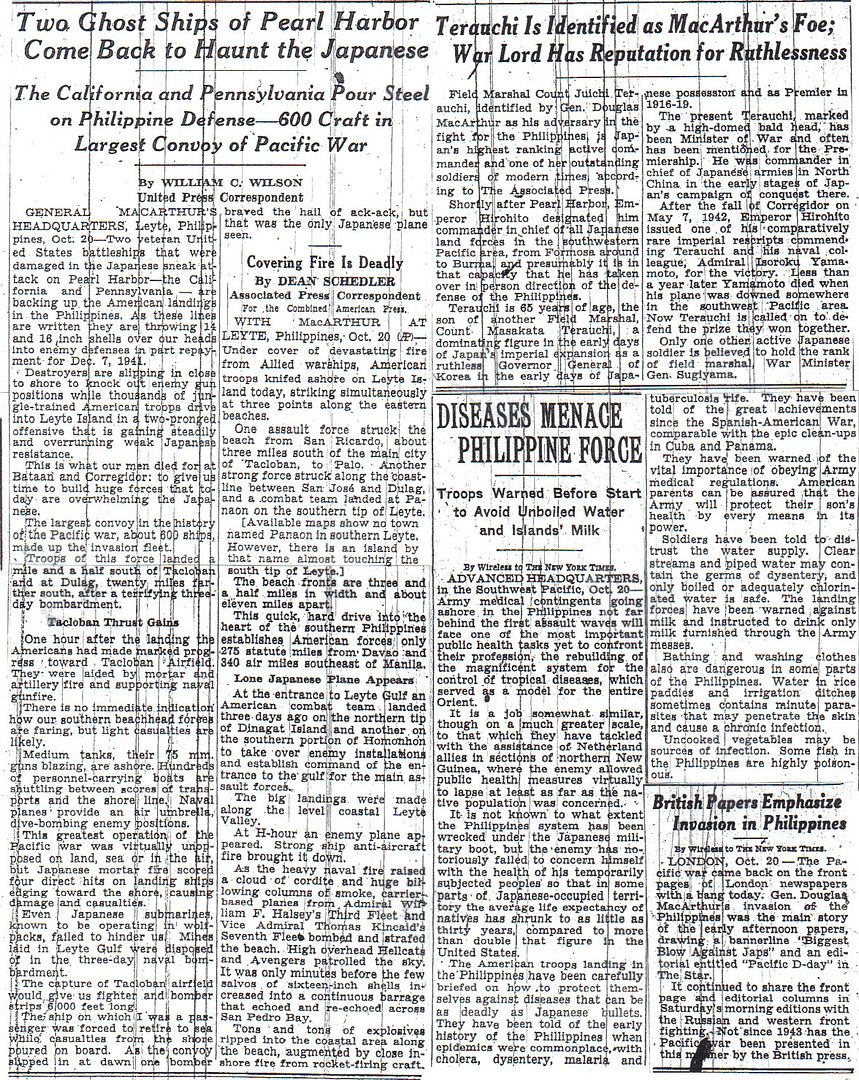
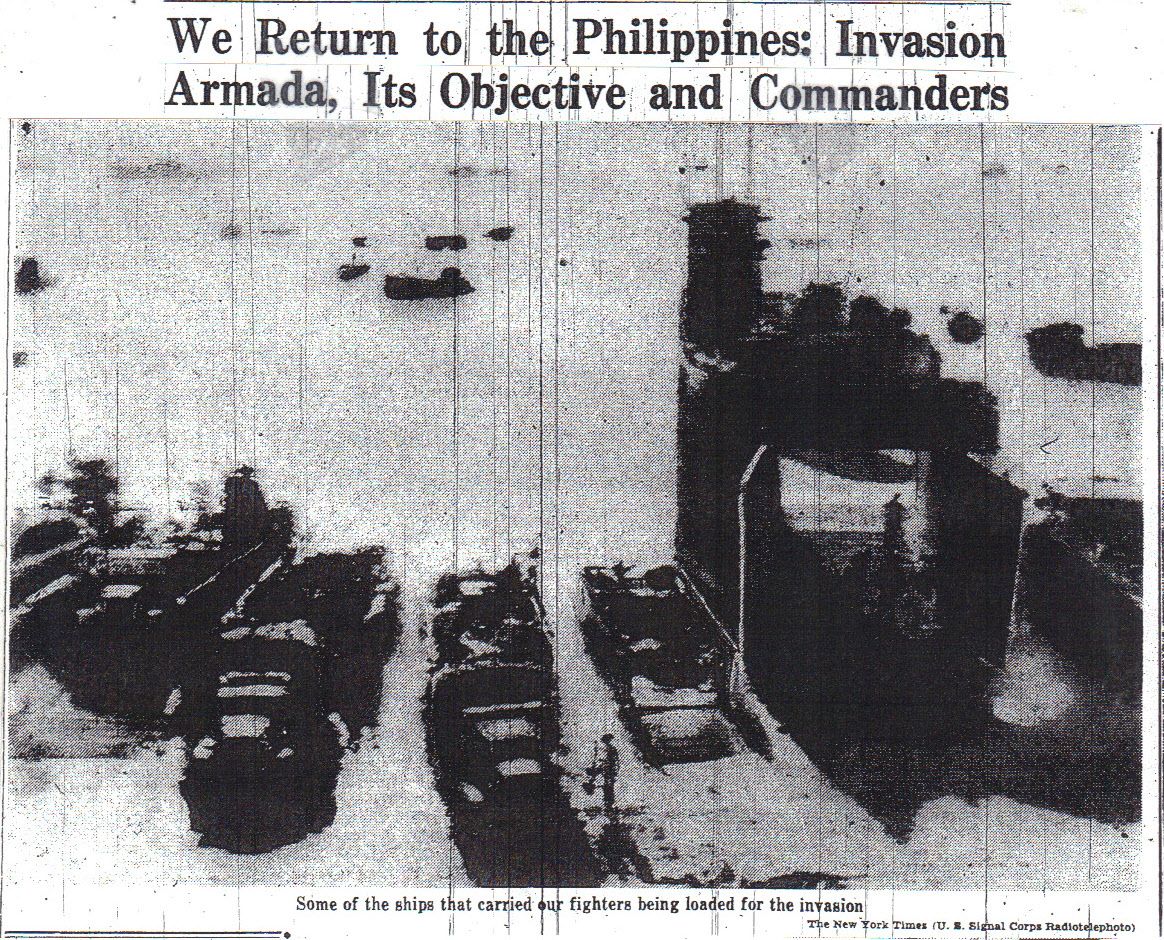
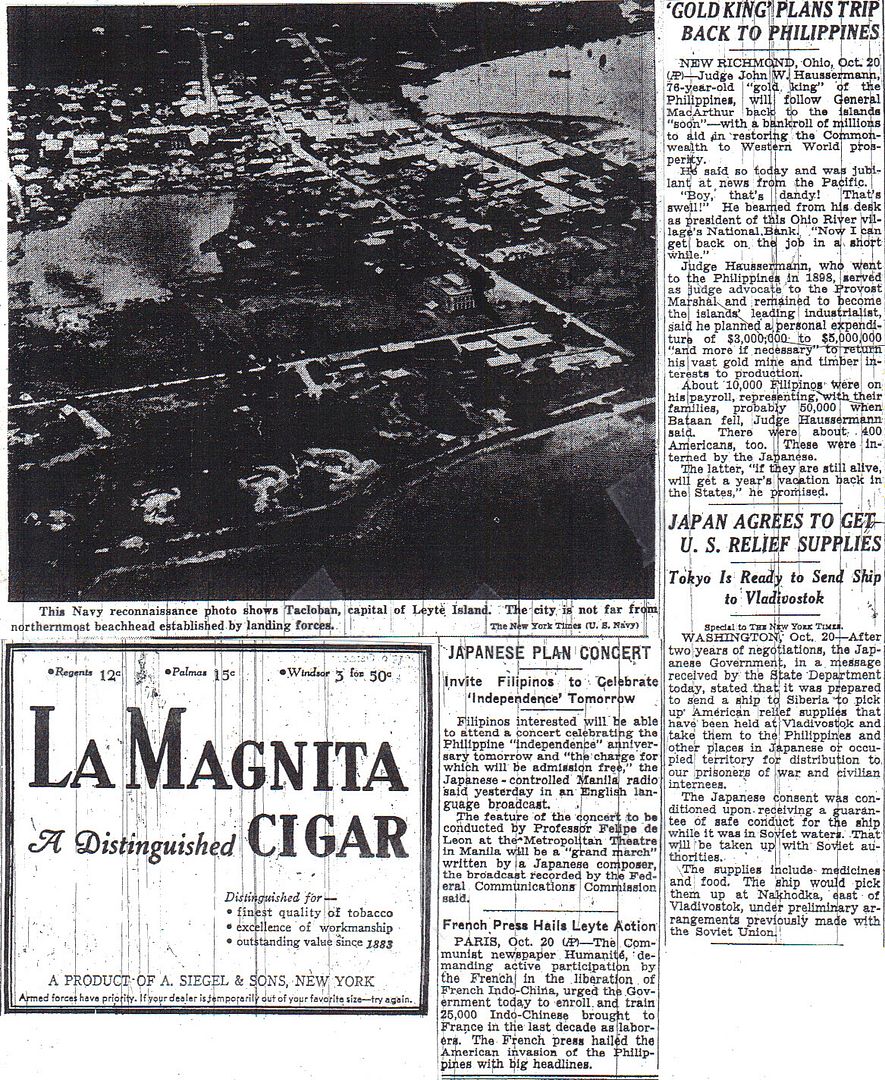
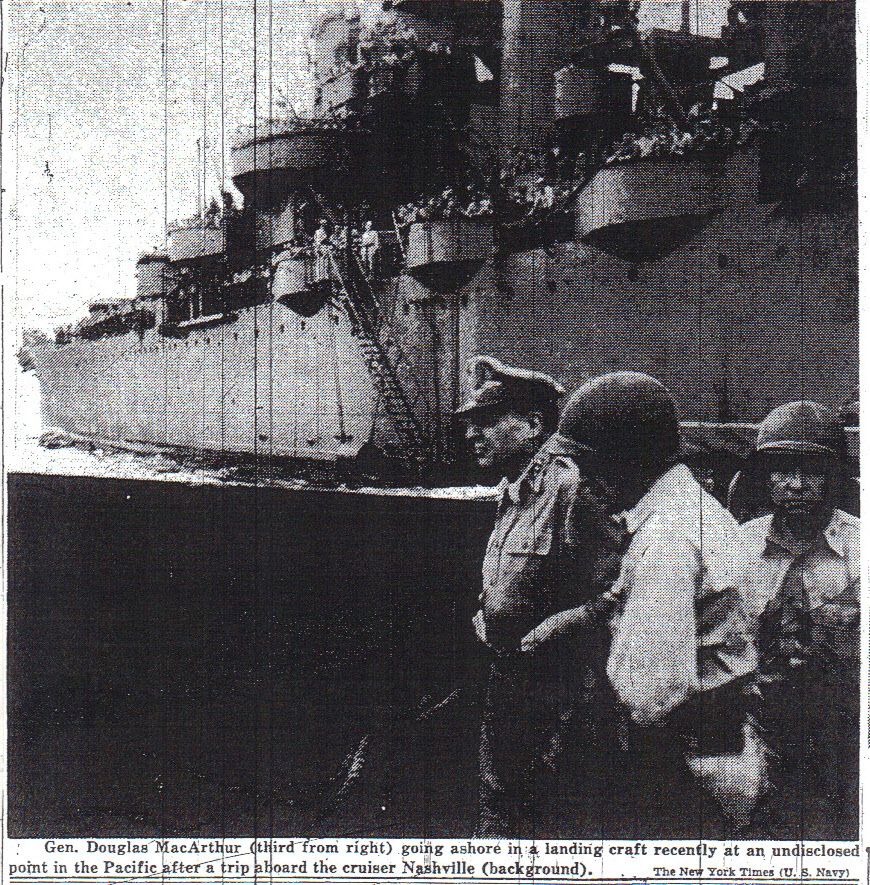

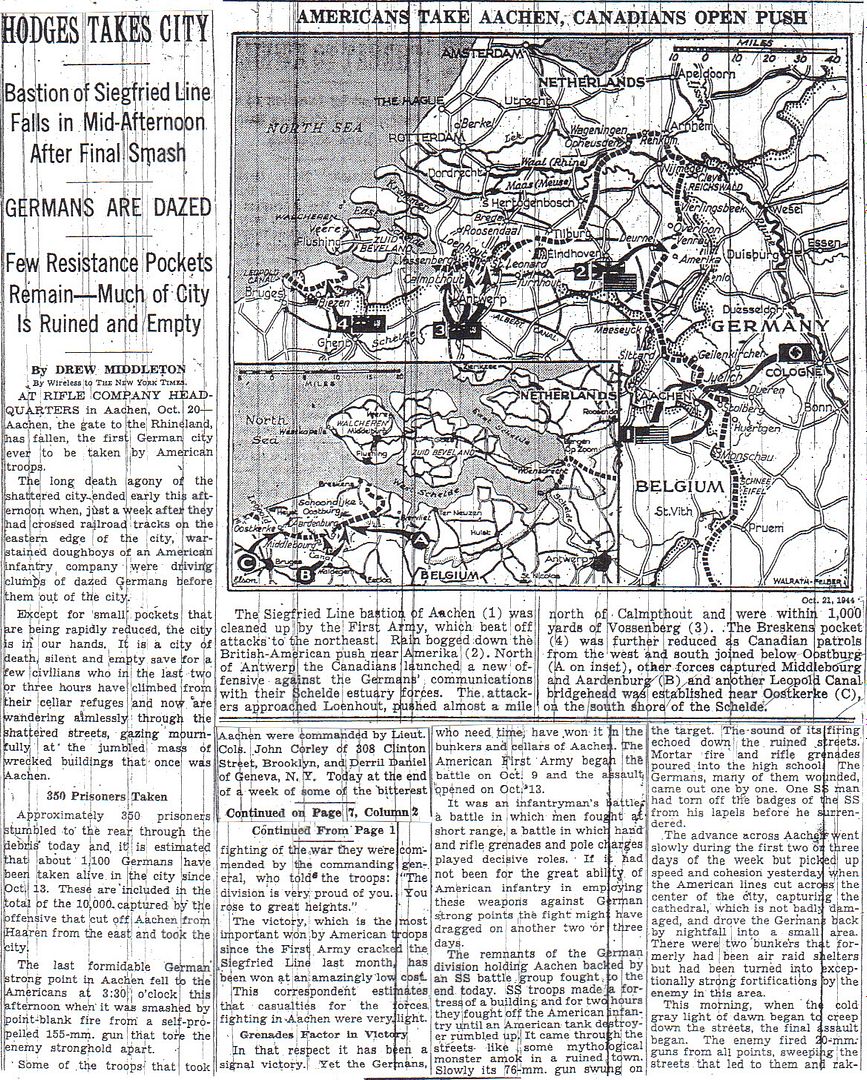
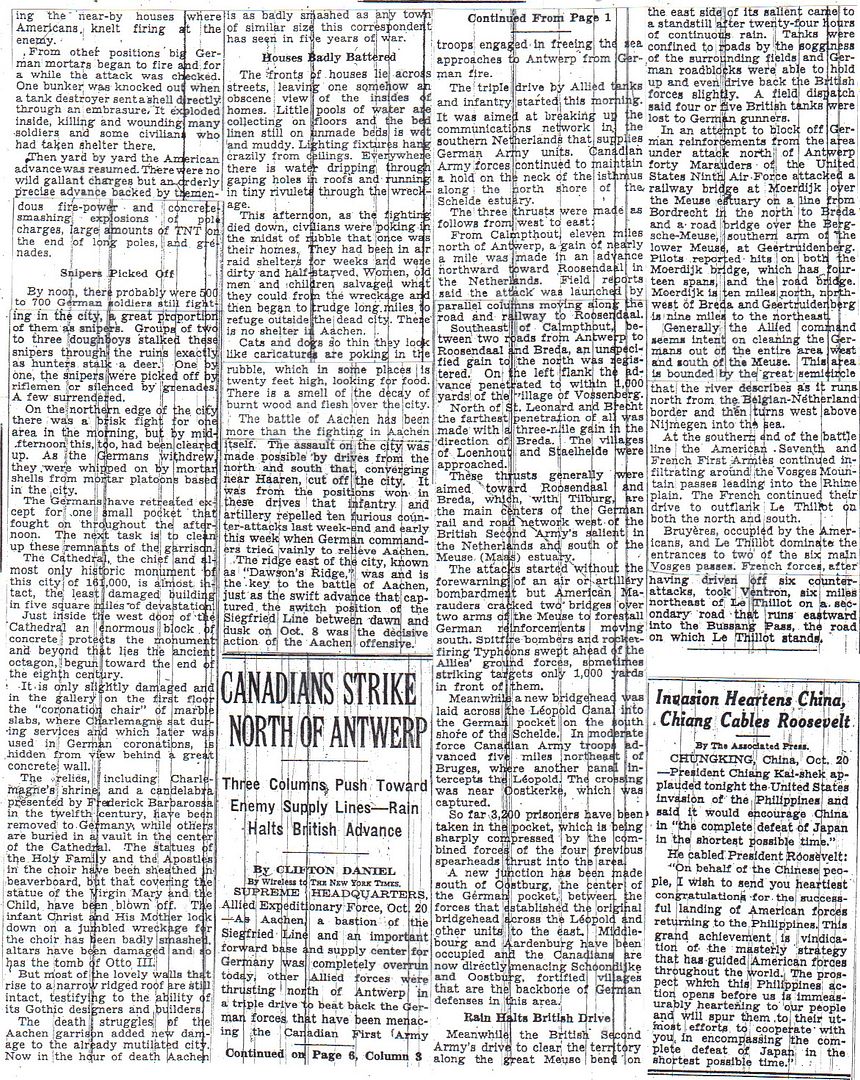
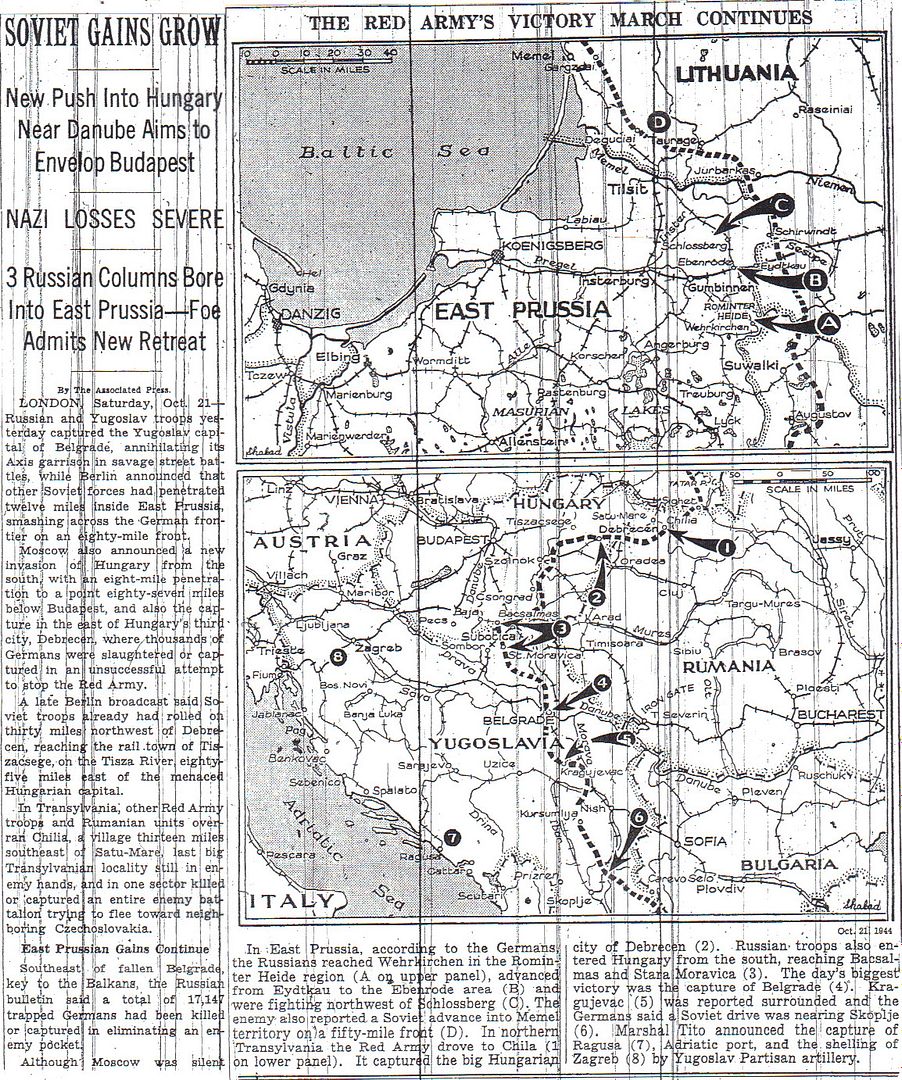
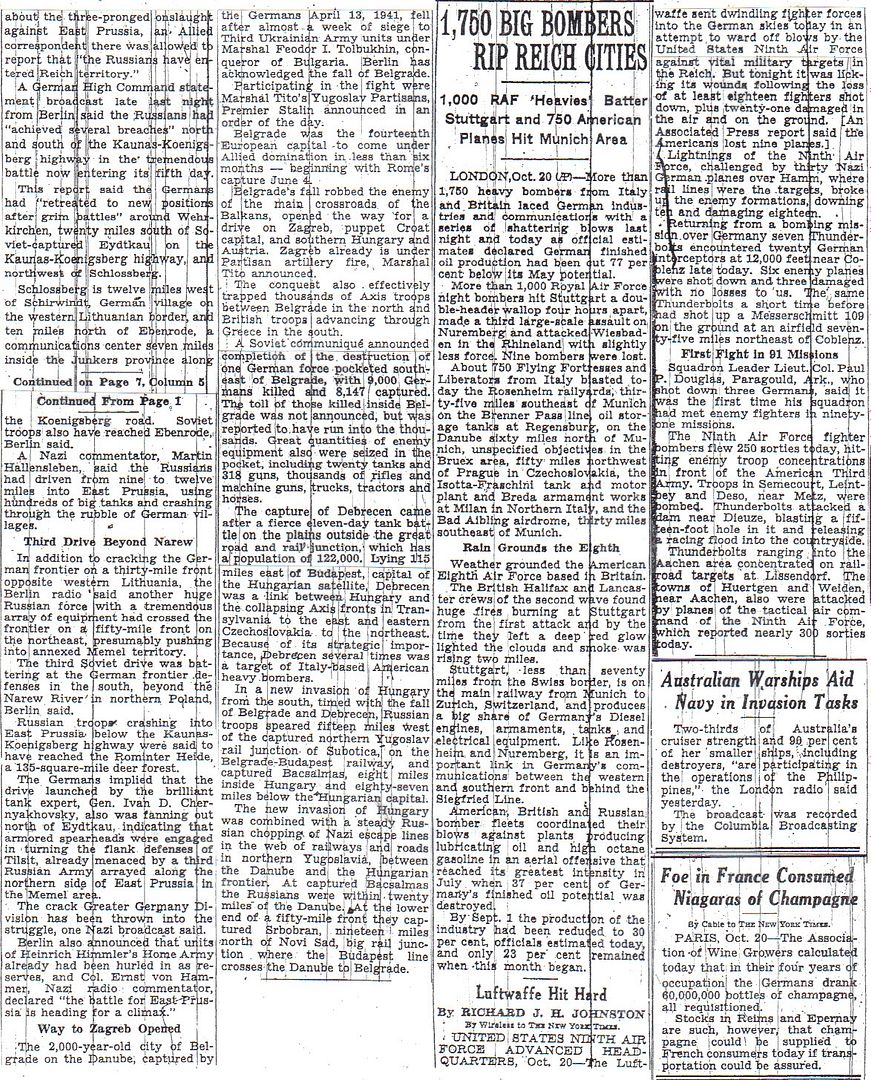
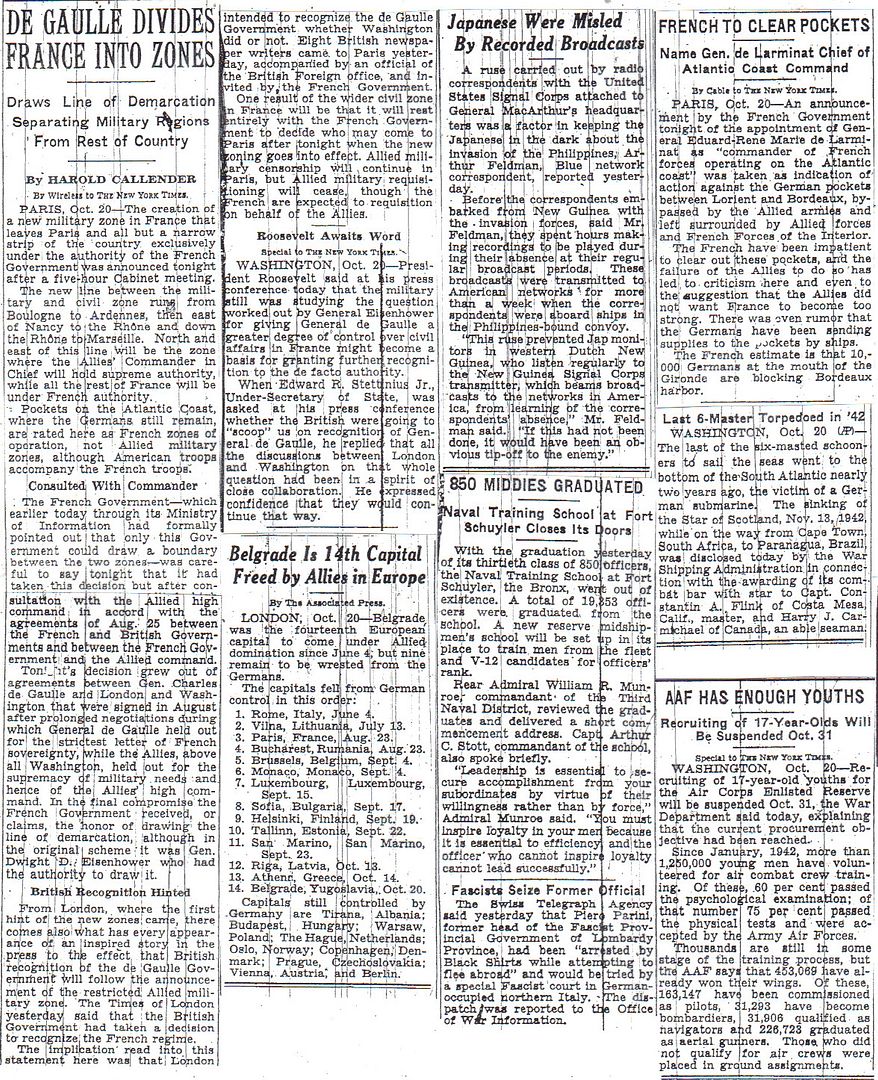

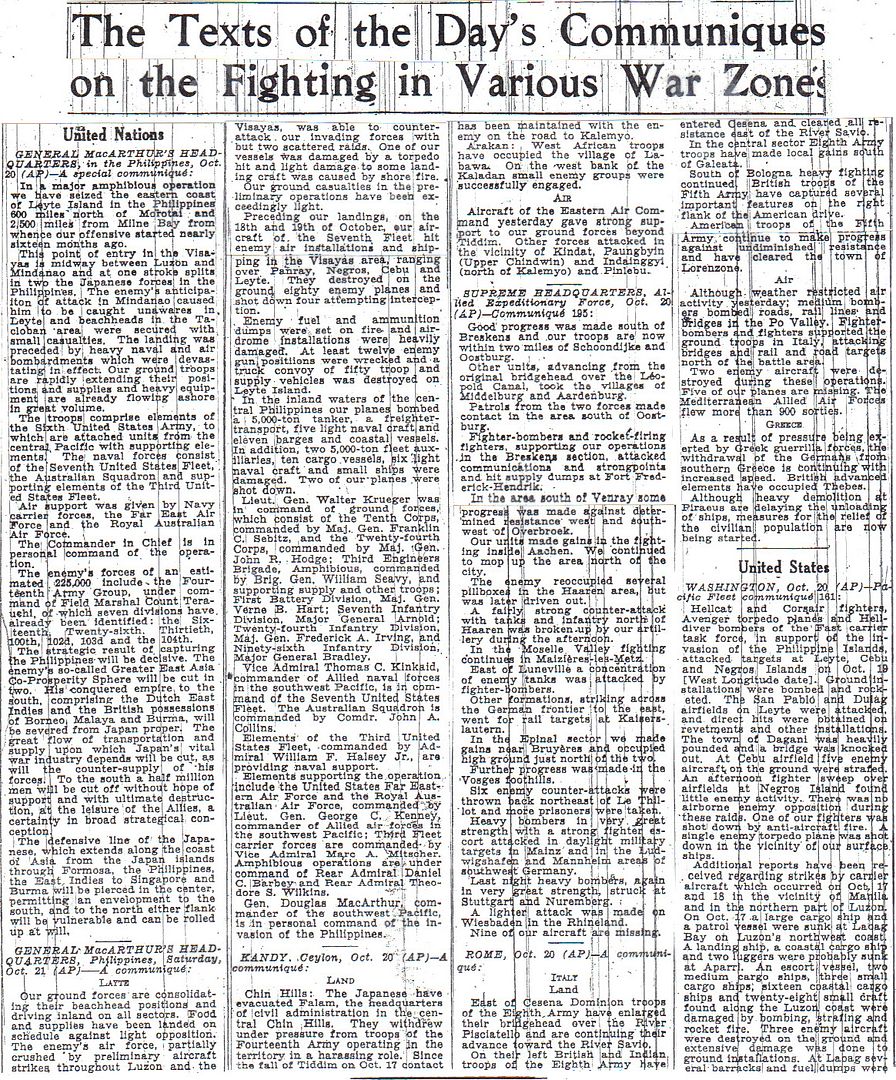
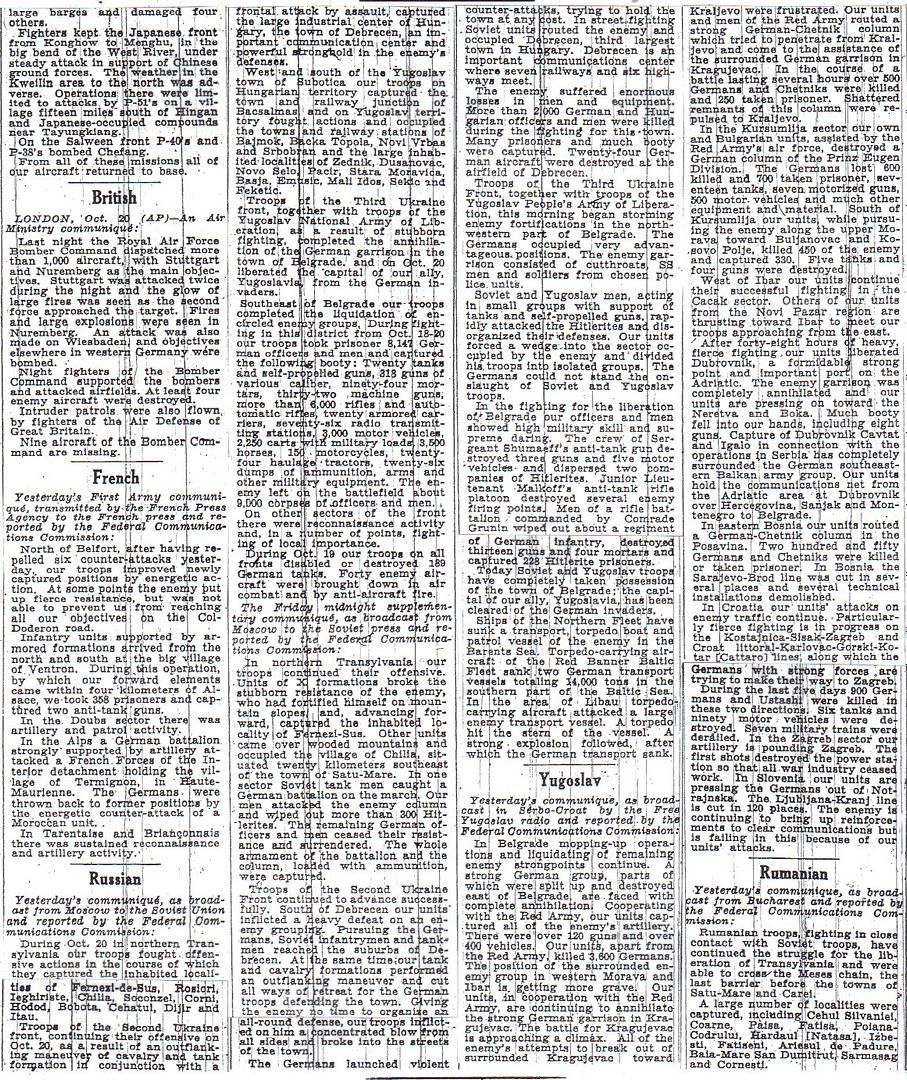
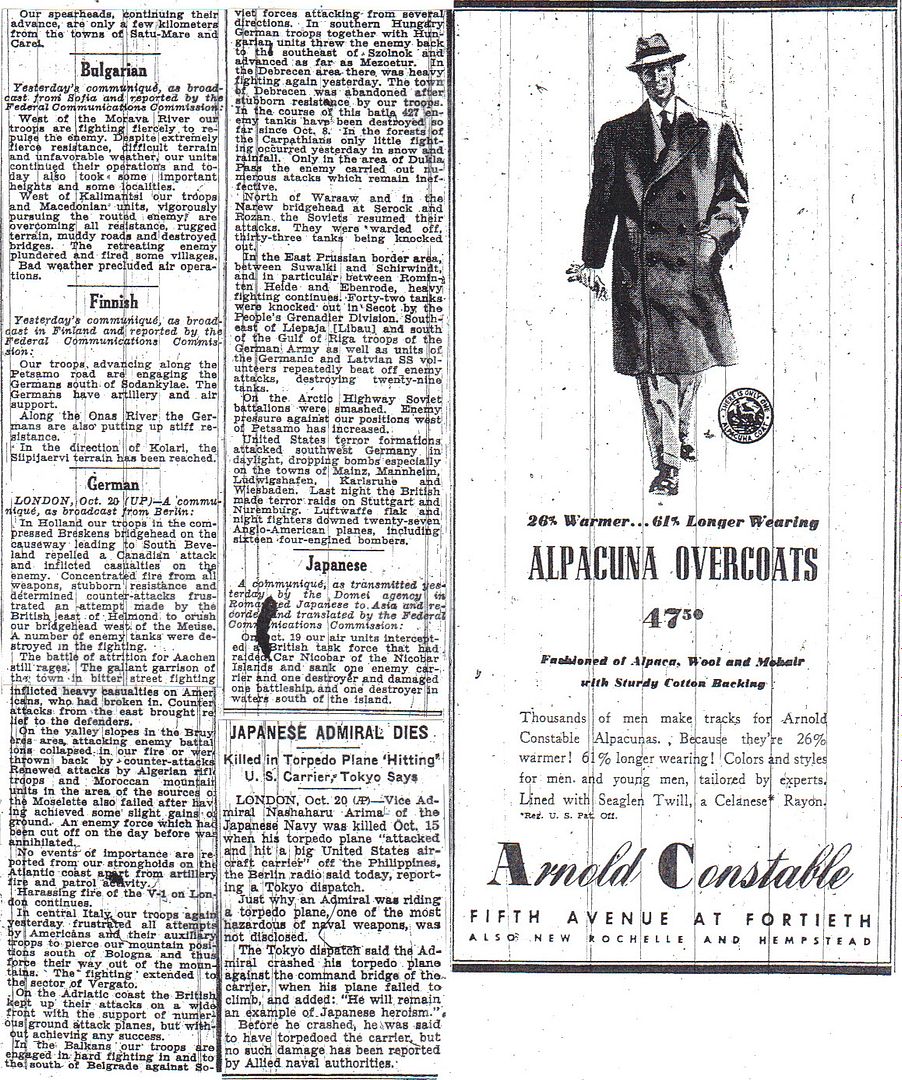

John Toland, The Rising Sun: The Decline and Fall of the Japanese Empire, 1936-1945
#1 - “You Always Hurt the One You Love” – Mills Brothers
#2 – “Is You Is or Is You Ain’t (Ma’ Baby)” – Bing Crosby, with the Andrews Sisters
#3 - “I’ll Walk Alone” – Dinah Shore
#4 - “Swinging on a Star” – Bing Crosby
#5 – “I’ll Walk Alone” – Martha Tilton
#6 - “I’ll Walk Alone” – Mary Martin
#7 - “Together” – Dick Haymes and Helen Forrest
#8 – “And Her Tears Flowed Like Wine” – Stan Kenton, with Anita O’Day
#9– “It Had to Be You” - Dick Haymes/Helen Forrest
#10 - “The Trolley Song” – Pied Pipers
"Head bowed in defeat, the commander of the German garrison in Aachen, Germany, Colonel Gerhard Wilck, accompanied by three of his officers, sits in a U.S. Army jeep after his capture.
Although months of fighting, including the Battle of the Bulge, lay ahead, the German defeat now appeared to be only a matter of time as the Western Allies pushed toward the Rhine and the Soviets moved into East Prussia.
With the capture of Aachen on October 21, American troops stood for the first time on German soil."
"Ala Gertner, one of the heroines of the 1944 Sonderkommando uprising in Auschwitz-Birkenau, strikes a stylish pose in this photograph from happier days in prewar Bedzin, Poland.
Deported with her husband to Auschwitz, she was assigned to work in the Union Munitions factory.
There she and two of her fellow workers managed to steal and hide the explosives the Sonderkommando used to blow up the crematorium on October 7.
Arrested, held in a bunker, and tortured, she died without betraying her accomplices."
"In the annals of Holocaust heroism, Roza Robota holds a special place.
An activist in the Zionist underground of Poland, she was deported to Auschwitz in 1942.
Her strong spirit was not broken by the horrors of Auschwitz-Birkenau, and she became a link between the women's camp and the resistance that was forming within the men's camp.
Detailed to a factory manufacturing bombs, she and several other brave women began to smuggle out small quantities of gunpowder with which the underground planned to blow up a Birkenau crematorium in October 1944.
Caught and questioned, along with three other women working in the factory, Roza refused to divulge any information, even under prolonged torture.
"Her execution by hanging before the camp population was intended to extinguish any fires of resistance.
Roza left her comrades with a different memory, as she yelled 'Nekama!' ("Revenge!") just before her death."
http://www.onwar.com/chrono/1944/oct44/21oct44.htm#
Aachen surrenders to Americans
Saturday, October 21, 1944 www.onwar.com
American troops enter Aachen [photo at link]
On the Western Front... Aachen is surrendered to American forces.
In Italy... British 5th Corps and Canadian 1st Corps continue to cross the Savio River.
In the Palau Islands... Organized Japanese on Angaur ends. A total of 1300 Japanese are killed and 45 are captured. American forces have suffered 265 dead and 1335 wounded. US heavy bombers are operating from the airfield. The Japanese garrisons on the remaining isldands in the group are left isolated.
In the Philippines... Elements of US 24th Corps capture Dulag Airfield; Tacloban village is taken by forces of US 10th Corps. American forces are unable to link the two beachheads. Ships of the US 7th Fleet and one group of US Task Force 38 (part of US 3rd Fleet) provide naval and air support to the land battles. Meanwhile, two groups of TF38 launch air strikes against targets on Panay, Cebu, Negros and Masbate.
http://www.etherit.co.uk/month/9/21.htm
October 21st, 1944 (SATURDAY)
NORTH SEA: The German patrol boat F 631 attacked U-245 in the North Sea by error.
WESTERN EUROPE: Bad weather grounds USAAF Ninth Air Force bombers. Fighters fly armed reconnaissance and attack railroads in western Germany and support elements of the U.S. Third and Seventh Armies in eastern France and western Germany.
NETHERLANDS: During the day, 75 RAF Bomber Command Lancasters carry out an accurate visual bombing of a coastal battery at Flushing; one Lancaster is lost.
FRANCE: U.S. Lieutenant General Omar Bradley, Commanding General 12th Army Group, orders the U.S. Ninth, First, and Third Armies to prepare for a drive to the Rhine, with 5 November as the target date for the Ninth and First Armies and 10 November for the Third Army.
In the U.S. Seventh Army’s XV Corps area, the 79th Infantry Division launches a full scale assault on the heights east of Foret de Parroy, with the 313th Infantry Regiment on the left, the 315th in the center, and the 314th on the right. Some progress is made against strong opposition. In VI Corps area, the 179th Infantry Regiment of the 45th Infantry Division enters Brouveleures after the main body of Germans has withdrawn and begins to clear rear-guard opposition. As the 7th Infantry Regiment continues toward St Die, clearing Domfaing, the 3d Infantry Division commits the 15th Infantry Regiment to the left. The 36th Infantry Division is improving positions east of Bruyêres.
GERMANY: Aachen finally surrenders to US forces. The extended battle by elite German formations including paratroopers, and ten day siege leaves much of it in ruins.
The city was taken only after close-quarter battles fought from house to house. Five brave attempts to break the siege line were made last night, all broken by American fire-power. This morning the garrison commander, Col. Gerhardt Wilck, sent two US captives as messengers to negotiate surrender. With about 400 men he marched to the headquarters of Lt-Col. John Cortez to insist upon proper treatment for his defeated soldiers.
From the back of a US Jeep he told his men: “I believe further fighting is useless. I have acted against my orders, to fight to the last man. The American commander says I cannot give you ‘Sieg Heil’ or ‘Heil Hitler’, but we say it in our hearts.”
The garrison, totalling 1,626 men, had run out of food, ammunition and water. Most of the town’s ancient streets had become impassable because of debris. In the centre only the mediaeval cathedral was still basically intact. The civilian population demanded a surrender ten days ago.
Berlin: Once again Grand Admiral Donitz has shown himself to be a formidable opponent. The Royal Navy hoped that the war at sea would be virtually over as soon as the Allied forces captured the heavily-armoured French bases which have harboured the U-boats for most of the war.
Donitz was ahead of them. He moved the main U-boat fleet out to bases in Norway and has been rapidly refitting the fleet with a newer and more sophisticated Schnorkel. Yet despite the new device, the Allies managed to sink 19 U-boats last month.
The advantages of the Schnorkel were demonstrated by Count von Matuschka in U-482. He did a round voyage from Norway of 2,729 miles, over 90% of which was under water. He preyed undetected on the main sea route north of Ireland and sank the corvette HMS HURST CASTLE and four ships.
The Schnorkel is a long tube which extends up to the surface and enables air to be drawn into the submarine while it is submerged. It has a valve which closes if a large wave sweeps over the tube. The valve stops water getting in - but it also cuts off the air, brings the U-boat crew near to suffocation, and hurting their eardrums when the air rushes in again. The Germans first started experimenting with Schnorkel devices as early as 1940.
Donitz started to fit them in large numbers as soon as he realized that British aircraft were decimating the U-boats. The Schnorkel not only allows them to stay submerged but also enables them to pick up long-range wireless signals undetected by the British. It does tend to slow a U-boat by several knots. So far German successes have been small in number. But the presence of the Schnorkel boats is still tying up a large number of Royal Navy ships in escort duties for merchant ships.
During the night of 21/22 October, RAF Bomber Command sends 242 Halifaxes and 21 Pathfinder Lancasters to bomb Hannover but they are recalled because of deteriorating weather in England. All aircraft landed safely. Meanwhile RAF Mosquitos attack four targets: four bomb Pforzheim, two hit Dusseldorf , and one each attack Cologne and Leverkusen. There are no losses.
U-2356, U-2357, U-2536 laid down.
U-3513, U-3514 launched.
U-2341 commissioned.
HUNGARY: Elements of the Soviet Second Ukrainian Front pushing west from Szeged reach the Danube River at Baja, south of Budapest.
B-24 Liberators of the USAAF Fifteenth Air Force bombs two marshalling yards (M/Y): 104 aircraft bomb the M/Y at Szombathely and 49 bomb the Main M/Y at Gyor without loss. Almost 100 P-38 Lightnings and P- 51 Mustangs escorts strafe Szombathely and Seregelyes Airfields and rail lines between Sajoszentpeter to Ipolyszog.
During the night of 21/22 October, an RAF bomber of No. 205 (Heavy Bomber) Group drops leaflets over Budapest.
YUGOSLAVIA: During the night of 21/22 October, 60 RAF bombers of No. 205 (Heavy Bomber) Group bomb the marshalling yard at Maribor; four aircraft are lost. Three other RAF bombers drop supplies to partisans.
ITALY: The British V and Canadian I Corps continue crossing the Savio River.
Pte. Ernest Alvia Smith (b.1914), Canadian Army, destroyed two tanks and two self-propelled guns and routed a number of German troops. (Victoria Cross)
In the U.S. Fifth Army area, the South African 6th Armoured Division commits fresh troops on Mt. Salvaro and completes the capture of Mt. Alcino. In the British XIII Corps area, the 38th Brigade of the 78th Division makes another unsuccessful attempt to take Mt. Spadura. The 21st Brigade, Indian 8th Division, pushes almost to the summit of Mt. Romano.
In the British Eighth Army’s Polish II Corps area, the 5th Kresowa Division, pressing northwest toward Route 67, which leads to Forli, takes Strada St. Zeno in the Rabbi River valley and the summit of Mt. Grosso. V Corps expands its three bridgeheads across the Savio River despite heavy rainfall and rapidly rising water. The Indian 10th Division’s 20th Brigade pushes toward Mt. Cavallo on the left flank of the corps while the 25th Brigade attacks to expand the bridgehead from St. Carlo. The 4th Division completes the capture of Cesena and crosses additional forces over the Savio River there, although handicapped by lack of a permanent bridge. In the Canadian I Corps area, The Canadian 1st Division at 2000 hours begins an attack across the Savio River with the 2d Brigade, supported by diversionary fire of the 3d Brigade, and secures a bridgehead.
USAAF Twelfth Air Force B-26 Marauders, in the days only medium bomber mission, attack the Nervesa della Battaglia railroad bridge and causeway; fighters and fighter-bombers operate in close support of the U.S. Fifth Army forces south of Bologna and fighter-bombers also hit communications in northern Italy as far north as Verona and as far west as Turin.
CHINA: Three USAAF Fourteenth Air Force B-25 Mitchells and 130+ P-40s and P-51 Mustangs attack shipping, gun positions, troop areas, bridges, town areas, road traffic, and other targets of opportunity around Yuma, Takhing, Dosing, Konghow, Shawan, Kuanyang, Kweiping, Tungpingchi, Tingka, Muse, Wan Lai-Kam, Shekpo, Menghsu, and Amoy.
BURMA: Fifteen USAAF Tenth Air Force P-47 Thunderbolts damage at least three bridges throughout the railroad corridor in northern Burma; 15 other P-47s support ground forces in the Mohnyin area, hitting gun positions and defensive works at Ywathit; 12 others attack positions and occupied areas around Bhamo and Muse, six knock out the Paungni River bridge, and four attack the town of Mawhun; about 270 sorties are flown by Tenth Air Force transports in the China-Burma-India Theater.
NEW GUINEA: In Northeast New Guinea, USAAF Fifth Air Force B-25 Mitchells and fighter-bombers hit Misami Island.
In Dutch New Guinea, USAAF Fifth Air Force fighter-bombers attack Mongosah (Cape Tanahmerh) and Sagan Aerodromes. Meanwhile, 81 (P-40) Kittyhawks of three Australian squadrons dive bomb the town of Mumi.
EAST INDIES: USAAF Far East Air Force B-24 Liberators bomb Parepare on Celebes Island.. Other fighter-bombers hit Kaoe Bay supply areas on Halmahera Island; Boela Aerodrome and Amboina town area on Ceram Island.
COMMONWEALTH OF THE PHILIPPINES: On Leyte Island, the Japanese decide to make a strong effort to defeat the Americans instead of fighting a delaying action as planned. Generals Walter Krueger, Franklin Sibert, and John Hodge take command ashore of Sixth Army, X Corps, and XXIV Corps, respectively. In X Corps area, 2d Brigade of the 1st Cavalry Division seizes Tacloban and southern half of hill to the southwest; the 1st Brigade drives west, taking Utap and Caibaan. The 34th Infantry Regiment, on the northern flank of the 24th Infantry Division, undergoes a determined Japanese counterattack, beginning at 0100 hours, in the Pawing area. Artillery and USN Seventh Fleet aircraft assist after daylight in routing the Japanese, more than 600 of whom are killed. The 2d Battalion then attacks the ridge to the west but cannot take it. The 19th Infantry Regiment clears the far slope of Hill 522 and, with strong fire support, takes Palo. In the XXIV Corps area, the 96th Infantry Division’s 383d Infantry Regiment begins working around Catmon Hill, which is actually a series of hill positions. 1st Battalion secures Labiranan Head but, since the Japanese remain in this area, pulls back to the Labiranan River. The 2d Battalion gains positions 300 yards (274 meters) north of Tigbao and the 3d Battalion, positions 1,110 yards (1 015 meters) north of the barrio. The 382d Infantry Regiment drives on Tigbao but is slowed by pillboxes as well as swampy terrain. The 7th Infantry Division attacks toward Dulag and Burauen Airfields with the 32d and 184th Infantry Regiments. The 32d, against considerable opposition, gets forward elements (2d and 3d Battalions) to the regimental beachhead line. The 184th Infantry Regiment easily takes Dulag Airstrip by 0900 hours and continues west to positions about 1,000 yards (914 meters) beyond the beachhead line, but a gap exists between it and 32d Infantry Regiment.
Naval support is from the US Seventh Fleet and one group of Task Force 38. Air strikes on Cebu, Panay, Negros and Masbate Islands are made by two other groups of TF 38.
At 0605 hours in the Leyte Gulf, a Japanese “Val” dive bomber (Aichi D3A, Navy Type 99 Carrier Bomber) crashes into the foremast of the heavy cruiser HMAS Australia (D 84). A fire starts but is put out by 0635 hours. The ship’s captain and 21 others are killed or die of injuries and 64 others are injured. The commodore’s staff transfers to the heavy cruiser HMAS Shropshire and HMAS Australia retires to Manus Island in the Admiralty Islands.
USAAF Far East Air Forces B-24 Liberators bomb Cagayan and B-25 Mitchells attack a truck convoy near Kibawe on Mindanao Island.
VOLCANO ISLANDS: Twenty eight USAAF Seventh Air Force B-24 Liberators from Saipan Island bomb Iwo Jima.
PALAU ISLANDS: The Japanese resistance on Angaur Island ends. Losses are: Japanese 1,300 KIA and 45 POW; US 264 KIA and 1355 WIA. US heavy bomber units are already operating from Angaur. The Palaus were declared secure on September 30 by US Admiral Fort.
CANADA: Light cruiser HMCS Uganda (ex-HMS Uganda) commissioned Charleston, South Carolina.
U.S.A.: Major General Clayton L. Bissell becomes Assistant Chief/Air Staff, Intelligence (A-2) in Washington, DC. He was formerly CG of the US 10th Air Force.
A new command, Marine Carrier Air Groups, is established under Aircraft, Fleet Marine Force, Pacific, to direct the formation and training of Marine Corps squadrons destined to operate from air support escort carriers. Current plans called for the formation of six Marine Carrier Air Groups, each composed of a fighter and a torpedo squadron, four of them to be assigned to escort carriers and two to function as replacement and training groups.
Submarine USS Chub commissioned.
Later, the Leyte operating was joined by the US 11th Airborne Division, the only complete airborne division in the Pacific
Theater. My dad who is still with us was an original member of the 511th PIR, the largest regiment of the 11th AB. They swept across the width of Leyte thru mountain jungles to Ormoc.
It looks like the 11th Airborne will arrive at Leyte on November 11. My father will arrive with the 32nd ID three days later. They had to wait until then because the transports that brought the initial landing force had to turn around and go back to New Guinea to pick up the reinforcements.
Thanks ...interesting...now I know more about what my father was doing in October of 1944 (he was an 18 yr old on a Navy ship in Battle of Leyte)...He never spoke of it..my great uncle told me about it after my father died in 1984.
Do you know what ship he was on?
Was he in The Battle of Bull’s Run?
I have the certificate from his passing over the equator...I think it names his ship...will try to find today...
I do not know
I think it was the General K L Scott...
I found a transport named Genera. H.L. Scott that could easily have been in the P.I. at this time. Was your father in the Coast Guard?
http://en.wikipedia.org/wiki/USS_General_H._L._Scott_%28AP-136%29
Not that I know...pretty sure he was in Navy...is there website where I can search using his name? I don’t have SS#...my parents divorced when I was 13 and I never saw him much after that...long story.
I found the General H l scott too...but info says it was destroyed by torpedo????
You can request his service record from this site.
http://www.archives.gov/veterans/military-service-records/
Unfortunately, most of the records of WWII vets were destroyed by a fire at the St. Louis archive around 1970. They still might have some basic information on your father.
Disclaimer: Opinions posted on Free Republic are those of the individual posters and do not necessarily represent the opinion of Free Republic or its management. All materials posted herein are protected by copyright law and the exemption for fair use of copyrighted works.